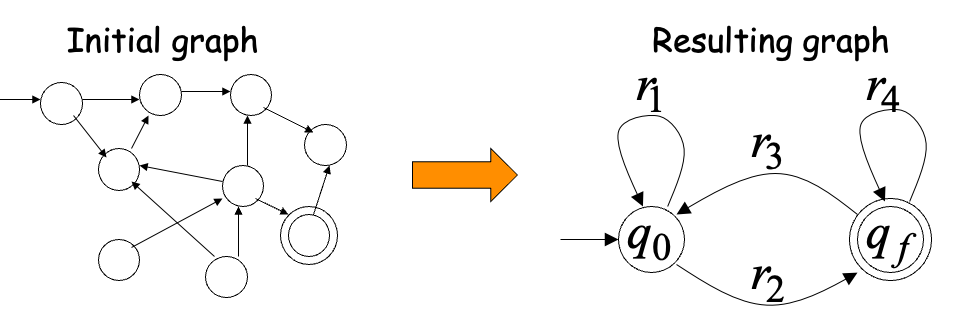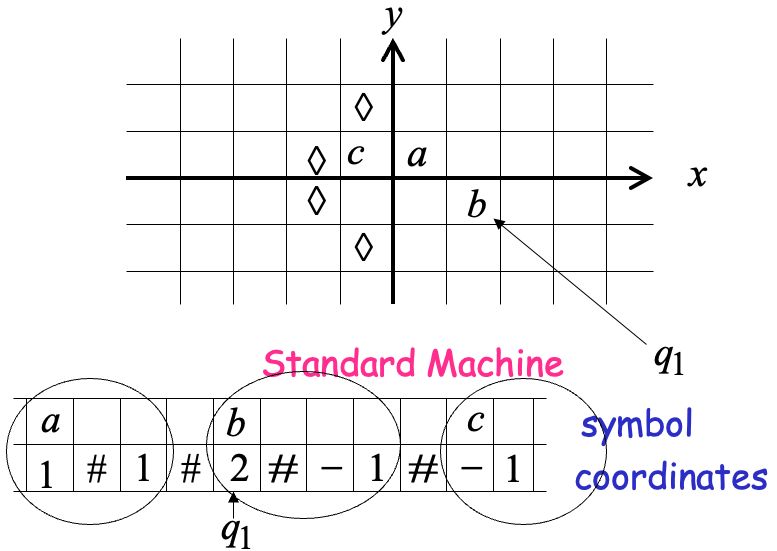LN1
Alphabets and Strings
An alphabet is a set of symbols
String: a sequence of symbols from some alphabet
Language: a set of strings
Unary numbers alphabet
Unary number: 1 11 111...
String Operations
- Concatenation
- Reverse
- String Length
Empty String: A string with no letters is denoted: or - Substring: a subsequence of consecutive characters
- Prefix and Suffix is prefix and is suffix
- Exponent Operation: and
- The * Operation
:the set of all possible strings from alphabet - The + Operation
Languages
A language over alphabet is any subset of
Empty language or
Operations on Languages
- The usual set operations: union, intersection, difference, complement
- Reverse:
- Concatenation:
- Star-Closure (Kleene *)
All strings that can be constructed from
- Positive Closure
LN2 Deterministic Finite Automata
For every state, there is a transition for every symbol in the alphabet
Formal Definition
Deterministic Finite Automaton (DFA)
- : set of states
- : input alphabet (:the input alphabet never contains empty string)
- : transition function
Extended Transition Function
Describes the resulting state after scanning string from state - : initial state
- : set of accepting states
Language Accepted by DFA
Language accepted by
Language rejected by
Regular Languages
A language is regular if there is a DFA that accepts it, which means
The languages accepted by all DFAs form the family of regular languages
LN3 Non-Deterministic Finite Automata
A NFA accepts a string:
if there is a computation path of the NFA that accepts the string.
all the symbols of input string are processed and the last is an accepting state2
A NFA rejects a string:
if there is no computation of the NFA that accepts the string.
For each possible computation path:
All the input is consumed and the automaton is in a non accepting state
or
The input cannot be consumed
- : transition function
(can be )
Note that for any state

Equivalence of Machines
Machine is equivalent to machine if
Languages accepted by NFAs = Regular Languages (aka Languages accepted by DFAs)
NFAs and DFAs have the same computation power, namely, they accept the same set of languages.
Proof:
- Languages accepted by NFAs Regular Languages. Because every DFA is trivially a NFA;
- Languages accepted by NFAs Regular Languages. Becasue any NFA can be converted to an equivalent DFA(We will show it later).
Conversion Procedure Steps
- Initial state of NFA is and , so that initial state of DFA is ;
- For every DFA’s state , compute in the NFA , then add transition to DFA ;
- Repeat Step 2 for every state in DFA and symbols in alphabet until no more states can be added in the DFA;
- For any DFA state , if some is accepting state in NFA, then is accepting state in DFA.
LN4 Properties of Regular Languages
We say Regular languages are closed under
- Union
- Concatenation
- Star
- Reversal
- Complement
- Intersection
Every NFA(also include NFA without accepting state) is equivalent to a NFA which contains single accept state.
LN5 Regular Expressions
Regular Expressions
Regular expressions describe regular languages
describes the language
Primitive regular expressions:
Given regular expressions , are regular expressions
Languages of Regular Expressions
means langguage of regular expression
Equivalent Regular Expressions
Theorem:Languages Generated by Regular Expressions = Regular Languages

When we say we are given a Regular Language , we mean Language is in a standard representation (DFA, NFA, or Regular Expression)
LN6 Regular Grammars
Gramars
Grammar
- : Set of variables
- : Set of terminal symbols
- : Start variable
- : Set of Production rules
Sentential Form :A sentence that contains variables and terminals
Language of a Grammar
For a grammar with start variable
is one string of terminals
Linear Grammars
Linear Grammars: Grammars with at most one variable at the right side of a production
A Non-Linear Grammar
means number of in string
Right-Linear Grammars:
All productions have form or
Left-Linear Grammars:
All productions have form or
Regular Grammars
A regular grammar is any right-linear or left-linear grammar
Regular grammars generate regular languages
Theorem Languages Generated by Regular Grammars Regular Languages = Regular Languages
For any transition add production
For any final state add production
LN7-8 Non-regular languages (Pumping Lemma)
Non-regular languages
The Pigeonhole Principle and DFAs
Considering number of states of DFA is , for a walk of , if , which means numbers of states in walk is at least , then a state is repeated in the walk
The Pumping Lemma
Take an infinite regular language, There exists a DFA that accepts
Take string with , then, at least one state is repeated in the walk of
Take to be the first state repeated
We can write , Where corresponds to substring between first and second occurrence of
Note that , because of unique states in (Since, in no state is repeated execpt )
Since there is at least one transition in loop,
We do not care about the form of string ( may actually overlap with the paths of and )
In General, the string is accepted
Therefore,
The Pumping Lemma:
- Given a infinite regular language
- there exists an integer (critical length)
- for any string with length
- we can write
- with and
- such that
Applications of the Pumping Lemma
Every language of finite size has to be regular
Therefore, every non-regular language has to be of infinite size
Assume for contradiction that is a regular language
Since is infinite we can apply the Pumping Lemma
Let be the critical length for
We pick
We can write
Thus
But , CONTRADICTION!!!
LN9 Context-Free Languages
Context-Free Grammars
Grammar
Describes matched parentheses:
Derivation Order and Derivation Trees
| derivation | 1 | 2 | 3 | 4 | 5 | 6 |
|---|---|---|---|---|---|---|
| leftmost | ||||||
| rightmost |
They give same derivation tree

Ambiguity
A context-free grammar is ambiguous if there is a string which has:
two different derivation trees or two leftmost derivations (Two different derivation trees give two different leftmost derivations and vice-versa)
In general, ambiguity is bad and we want to remove it
Sometimes it is possible to find a non-ambiguous grammar for a language
But, in general ιt is difficult to achieve this
LN10 Simplifications of Context-Free Grammars
A Substitution Rule
Nullable Variables -production
Unit-Productions
Useless Productions
Normal Forms for Context-free Grammars
Chomsky Normal Form Each production has form: or
Conversion to Chomsky Normal Form
It is easy to find the Chomsky normal form for any context-free grammar (which doesn’t generate )
Greinbach Normal Form All productions have form:
Greinbach normal forms are very good for parsing strings (better than Chomsky Normal Forms)
However, it is difficult to find the Greinbach normal of a grammar
LN11 Properties of Context-Free languages
Closed
- Union
- Concatenation
- Star Operation
Negative Properties of Context-Free Languages (not closed)
- Intersection
- Complement
Intersection of Context-free languages and Regular Languages(Applications of Regular Closure)
The intersection of a context-free language and a regular language is a context-free language
Prove that is not context-free
Becasue is regular, is not context-free.
So it's impossible that is context-free
LN12 Pushdown Automata PDAs
Pushdown Automaton -- PDA

Initial Stack Symbol

The States

- replace:
- push:
- pop:
- no change:
PDAs are non-deterministic
Allowed non-deterministic transitions
A string is accepted if there is a computation such that:
All the input is consumed AND The last state is an accepting state
we do not care about the stack contents at the end of the accepting computation
Formalities for PDAs
Pushdown Automaton (PDA)
- state
- Input alphabet
- Stack alphabet
- Transition function
- Initial state
- Stack start symbol
- Accept states
- Current state
- Remaining input
- Current stack content
Language accepted by PDA :
LN13 PDAs Accept Context-Free Languages
Theorem: Context-Free Languages (Grammars) = Languages Accepted by PDAs
Convert Context-Free Grammars to PDAs
For each terminal in , add
For each production in , add
e.g.
PDA:
Grammar Leftmost Derivation
PDA Computation
Grammar generates string if and only if PDA accepts
Convert PDAs to Context-Free Grammars
Too long to wirte down here
LN14 DPDA Deterministic PDA
Definition
is DPDA
is not DPDA
because is not allowed in DPDA
PDAs Have More Power than DPDAs
We will show that there exists a context-free language which is not accepted by any DPDA
Which means Deterministic Context-Free Languages(DPDA) Context-Free
Languages(PDA)
e.g. is context-free but not deterministic context-free
Because if there is a DPDA accept , we will get a DPDA accepting by modifying , replacing with
The language is not context-free(we can prove this using pumping lemma later)
LN15-16 Pumping Lemma for Context-free Languages
The Pumping Lemma:
For any infinite context-free language
there exists an integer such that
for any string
we can write
with length and
and it must be that:
LN17 Turing Machines
Turing Machines are deterministic
The tap with infinite length
The head at each transition (time step):
- Reads a symbol
- Writes a symbol
- Moves Left or Right
Turing Machines are deterministic(No -transitions allowed)
No transition for input symbol is allowed
Halting
The machine halts in a state if there is no transition to follow
Accepting states have no outgoing transitions
The machine halts and accepts
Accept Input String = If machine halts in an accept state
Reject Input String = If machine halts in a non-accept state or If machine enters an infinite loop
In order to accept an input string, it is not necessary to scan all the symbols of the input string
Formal Definitions for Turing Machines
: Blank
A move
If a language is accepted by a Turing machine then we say that is:
- Turing Recognizable
- Turing Acceptable
- Recursively Enumerable
LN18 Turing’s Thesis
Turing’s thesis (1930):
Any computation carried out by mechanical means can be performed by a Turing Machine
An algorithm for a problem is a Turing Machine which solves the problem
Variations of the Turing Machine
Turing machines with:
- Stay-Option
- Semi-Infinite Tape
- Multitape
- Multidimensional
- Nondeterministic
Same Power of two machine classes:
both classes accept the same set of languages
each new class has the same power with Standard Turing Machine(accept Turing-Recognizable Languages)
Turing Machines with Stay-Option
The head can stay in the same position
L,R,S: possible head moves
- Stay-Option Machines simulate Standard Turing machines
because any standard Turing machine is also a Stay-Option machine - Standard Turing machines simulate Stay-Option machines
because for any transition we can replace it with and for every possible tape symbol
Semi-Infinite Tape
Multiple Track Tape
It is a standard Turing machine, but each tape alphabet symbol describes a pair of actual useful symbols
The head extends infinitely only to the right and Initial position is the leftmost cell. When the head moves left from the border, it returns back to leftmost position
- Standard Turing machines simulate Semi-Infinite machines
We can insert special symbol # at left of input string and add a self-loop to every state (except states with no outgoing transitions) - Semi-Infinite tape machines simulate Standard Turing machines
choose a reference point and generate a Semi-Infinite tape machine with two tracks(right part and left part)
Multi-tape Turing Machines
- Multi-tape machines simulate Standard Turing machines
Just use one tape - Standard Turing machines simulate Multi-tape machines
Uses a multi-track tape to simulate the multiple tapes. A tape of the Multi-tape machine corresponds to a pair of tracks
Note that same power doesn’t imply same speed
, Standard Turing machine needs time but 2-tape machine needs time(copy to tape 2 and compare tape 1 and tape 2)

Multidimensional Turing Machines
MOVES: L,R,U,D
- Multidimensional machines simulate Standard Turing machines
Just use one dimension - Standard Turing machines simulate Multidimensional machines
Use a two track tape; Store symbols in track 1; Store coordinates in track 2
Nondeterministic Turing Machines
- Nondeterministic machines simulate Standard Turing machines
every deterministic machine is also nondeterministic - Standard (deterministic) Turing machines simulate Nondeterministic machines
Uses a 2-dimensional tape(equivalent to standard Turing machine with one tape)
LN19 Universal Turing Machine
A Universal Turing Machine
Tape 1 contents of Universal Turing Machine: binary encoding of the simulated machine which is description of (different numbers of '1's means different symbols while '0's means separators)
A Turing Machine is described with a binary string of 0’s and 1’s
Therefore, the set of Turing machines forms a language: each string of this language is the binary encoding of a Turing Machine
Tape 2 contents of Universal Turing Machine: Tapes Contents of
Tape 3 contents of Universal Turing Machine: State of
Countable Sets
There is a one to one correspondence (injection) of elements of the set to Positive integers (1,2,3,…)
e.g. The set of rational numbers is countable
Let be a set of strings (Language)
An enumerator for is a Turing Machine that generates (prints on tape) all the strings of one by one and each string is generated in finite time
Theorem: The set of all Turing Machines is countable
Proof: Any Turing Machine can be encoded with a binary string of 0’s and 1’s.
Find an enumeration procedure for the set of Turing Machine strings
Enumerator: Repeat:
- Generate the next binary string of 0’s and 1’s in proper order
- Check if the string describes a Turing Machine
if YES: print string on output tape
if NO: ignore string
Simpler Proof:
Each Turing machine binary string is mapped to the number representing its value
Uncountable Sets
If is an infinite countable set, then the powerset of is uncountable.
Since Languages accepted by Turing machines is countable but All possible languages is uncountable. There is a language not accepted by any Turing Machine.
LN20 Decidable
Decidable Languages
Turing-Acceptable=Turing-Recognizable=Recursively-enumerable
A language is decidable if there is a Turing machine (decider) which accepts and halts on every input string (Also known as recursive languages).
For any input string
If , halts in an accept state; else halts in a non-accept state.
Note that Every decidable language is Turing-Acceptable
We can convert any Turing machine to have single accept and reject states
Decider: For each input string, the computation halts in the accept or reject state
Turing Machine for : It is possible that for some input string the machine enters an infinite loop
A computational problem is decidable if the corresponding language is decidable. We also say that the problem is solvable.
Problem: Is number prime?
Corresponding language:
Decider for : On input , divide with all possible numbers between and . If any of them divides Then reject else accept.
Problem: Does DFA accpet the empty language ?
Corresponding Language:
Decider for : On input , Determine whether there is a path from the initial state to any accepting state
Problem: Does DFA accpet a finite language?
Corresponding Language:
Decider for : On input , Check if there is a walk with a cycle from the initial state to an accepting state
Check if
which is a solvable problem for DFAs:
Theorem: If a language is decidable, then its complement is decidable too
Undecidable Languages
An undecidable language has no decider: Any Turing machine that accepts does not halt on some input string
If is Turing-acceptable but is not Turing-acceptable, is undecidable such as
LN21 Undecidable
Undecidable Problems
Membership problem
is Turing-acceptable but undecidable
Halting Problem
is Turing-acceptable but undecidable
LN22 Reductions
Reductions
Computable function : There is a deterministic Turing machine which for any input string computes and writes it on the tape
Problem is reduced to problem : If we can solve problem then we can solve problem , which means there is a computable function such that
Theorem 1:
If: Language is reduced to and language is decidable
Then: is decidable
